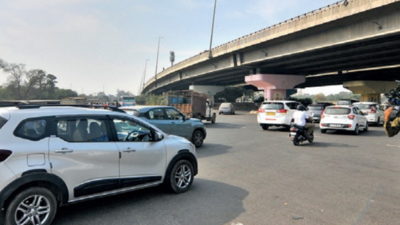Top Searches
- News
- City News
- gurgaon News
- Will new Delhi-Mumbai expressway add to traffic load on key junctions?
Will new Delhi-Mumbai expressway add to traffic load on key junctions?

Trafiic policeman at Rajiv Chowk
GURGAON: With the opening of the Sohna-Dausa section of the Delhi-Mumbai Expressway, traffic at Rajiv Chowk and Subhash Chowk is expected to increase manifold in the days to come. To ensure smooth flow of vehicles at these busy junctions, particularly during the peak hours, Gurgaon traffic police have deployed more personnel.
“We have deployed additional traffic policemen at Rajiv Chowk and Subhash Chowk, anticipating an increase in traffic volume at these two intersections,” DCP (traffic) Virender Singh Sangwan told TOI. “More changes to prevent congestion at these junctions will be made in the future, depending on the traffic volume.”
The National Highways Authority of India (NHAI) has already started developing a state-of-the-art sub-control room in Alipur for traffic management on the 78km of the Haryana stretch of the expressway. Until it’s developed, a sub-control room is keeping a vigil on the high-speed corridor.
Cops expect some Jaipur-bound traffic from the Delhi-Jaipur highway to take the newly inaugurated Sohna-Dausa section of the Delhi-Mumbai Expressway. “This would put additional pressure on these two junctions and service roads. We have made advance planning to ensure movement of traffic without any disruption,” the DCP said.
The 246km Sohna-Dausa stretch of the expressway was inaugurated recently by Prime Minister Narendra Modi and the highway was opened for regular traffic from February 15.
“An intelligent transportation system and advanced traffic management system has already been put in place on the expressway, which helps us monitor the traffic, check violations like speeding and illegal parking, and ensure immediate dispatch of response teams in case of an accident,” an NHAI official said.
In fact, high-resolution CCTV cameras with a 360-degree view have also been installed at every 1km on the expressway as part of the intelligent transportation system. NHAI’s patrolling team along with the local police will provide the required support.
Traffic violations such as speeding, wrong-side driving, wrong parking and lane violation, will be immediately detected by the AI-enabled CCTV cameras and alert the control room in Alipur. Operators at the control room will analyse the data and a challan will be issued to the violators, the details of which will also be shared with the local police.
In case of any unscheduled stop, the cameras will alert the control room operators, who will then ask the vehicle’s driver to move via speakers mounted on poles along the road. A patrolling unit will be sent in if instructions aren’t followed. At this nerve centre, the cameras will also give operators visuals of any emergency or accident, consequently allowing them to act fast.
India’s longest expressway, once finished, will connect its two largest metropolises after traversing six states.
“We have deployed additional traffic policemen at Rajiv Chowk and Subhash Chowk, anticipating an increase in traffic volume at these two intersections,” DCP (traffic) Virender Singh Sangwan told TOI. “More changes to prevent congestion at these junctions will be made in the future, depending on the traffic volume.”
The National Highways Authority of India (NHAI) has already started developing a state-of-the-art sub-control room in Alipur for traffic management on the 78km of the Haryana stretch of the expressway. Until it’s developed, a sub-control room is keeping a vigil on the high-speed corridor.
Cops expect some Jaipur-bound traffic from the Delhi-Jaipur highway to take the newly inaugurated Sohna-Dausa section of the Delhi-Mumbai Expressway. “This would put additional pressure on these two junctions and service roads. We have made advance planning to ensure movement of traffic without any disruption,” the DCP said.
The 246km Sohna-Dausa stretch of the expressway was inaugurated recently by Prime Minister Narendra Modi and the highway was opened for regular traffic from February 15.
“An intelligent transportation system and advanced traffic management system has already been put in place on the expressway, which helps us monitor the traffic, check violations like speeding and illegal parking, and ensure immediate dispatch of response teams in case of an accident,” an NHAI official said.
In fact, high-resolution CCTV cameras with a 360-degree view have also been installed at every 1km on the expressway as part of the intelligent transportation system. NHAI’s patrolling team along with the local police will provide the required support.
Traffic violations such as speeding, wrong-side driving, wrong parking and lane violation, will be immediately detected by the AI-enabled CCTV cameras and alert the control room in Alipur. Operators at the control room will analyse the data and a challan will be issued to the violators, the details of which will also be shared with the local police.
In case of any unscheduled stop, the cameras will alert the control room operators, who will then ask the vehicle’s driver to move via speakers mounted on poles along the road. A patrolling unit will be sent in if instructions aren’t followed. At this nerve centre, the cameras will also give operators visuals of any emergency or accident, consequently allowing them to act fast.
India’s longest expressway, once finished, will connect its two largest metropolises after traversing six states.
Start a Conversation
FOLLOW US ON SOCIAL MEDIA
FacebookTwitterInstagramKOO APPYOUTUBE









